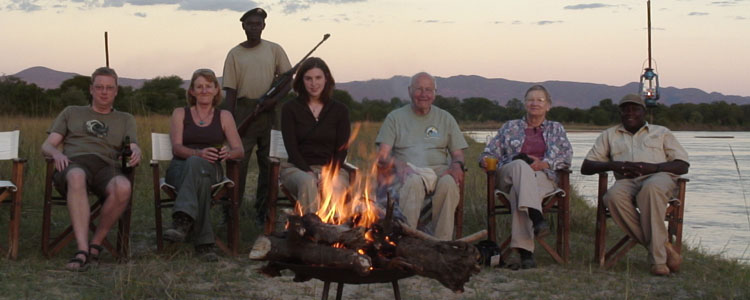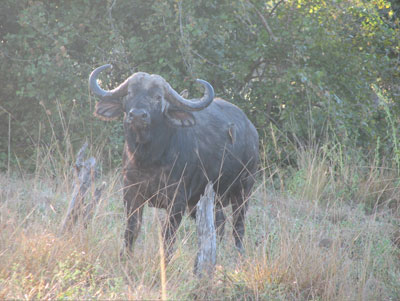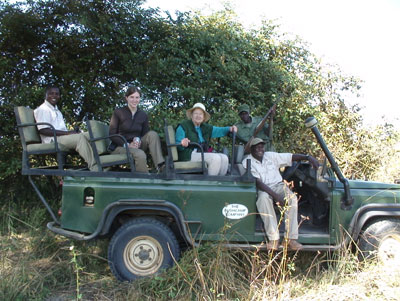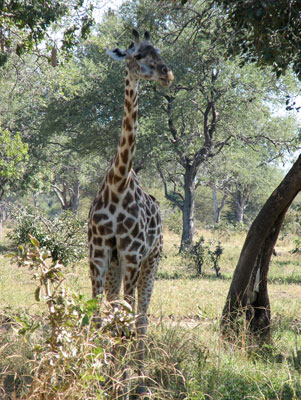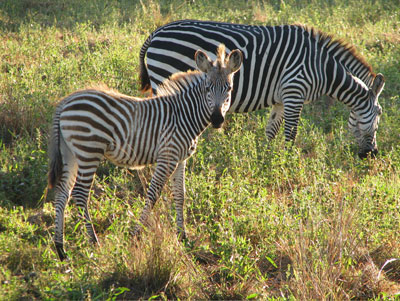Exposing the next generation to the wonders of Africa on a Zambian safari
by Herb Phillipson; Dowagiac, MI
Long ago I fell in love with Africa.
Many years ago the Chicago Council on Foreign Relations sponsored a trip to Kenya and Tanzania for $495. My first wife and I decided to go, taking my two teenage boys and an exchange student.
Since then, Eve, my present wife of 28 years, and I have driven ourselves around South Africa; we have twice taken the “Ultimate Africa” trip with Overseas Adventure Travel (Cambridge, MA; www.oattravel.com), which we heartily recommend, and we have undertaken a camping trip to Namibia, Botswana and Zambia with Wild Dog & Crazy Kudu Safaris (Windhoek, Namibia; www.wilddog-safaris.com), which was also excellent.
Enjoying Africa as I do, I decided it would be wonderful to take my granddaughter, Kea Wilson, to show her what I enjoy so much. We planned at 12-day trip for the end of May ’09.
Getting there
In preparing for the trip, I asked the readers of ITN for information on traveling to South Luangwa National Park in Zambia. We received a number of calls and letters and eventually contacted Journeys International (Ann Arbor, MI; 800/255-8735, www.journeys.travel).
This trip was Kea’s college graduation present. She graduated on May 17, and on May 19 we left from Dulles International Airport for Johannesburg, South Africa, connecting to Lusaka, Zambia, and eventually arriving in the town of Mfuwe, outside the entrance to Zambia’s South Luangwa National Park.
When we arrived at Lusaka there was no one to meet us; the transportation to our hotel had left without us. We caught a taxi and the hotel reimbursed us, so that ended well.
Camp life
Our first nights were spent at Flatdogs Camp (the nickname for “crocodile”), located just outside the park entrance. As we drove up to the camp we saw a group of female elephants with tiny babies — just a taste of things to come.
Our accommodations, in a duplex with mosquito net-covered beds, were satisfactory.
A guard accompanied us whenever we walked in the camp after dark. Apparently, having guards present at night to protect the guests is standard procedure in all the camps. You never know when you might meet a hippopotamus along the path!
Each morning we went on a game drive from 6 to 10 a.m., with a break for tea and biscuits at 8. After we returned we could order brunch, lunch or any other food at any time. We had another game drive at 4:00, looking for animals until 6, when we had a snack and drinks, and then continued spotting with a light until 8. Then we returned home for supper and a very deserved night’s rest.
In the morning we rose at 5 a.m. for a Continental breakfast, then hit the game trails again.
We had an excellent guide and saw lots of game. Impalas, puku, zebras, giraffes, kudu and bushbuck were in abundance. Eagles and beautiful birds were everywhere.
We saw many hippopotamuses, lions, elephants and Cape buffalo, all from the back of an open Land Rover. There is nothing like it.
We also had the opportunity to walk outside of the car in single file, led by a rifleman and our guide. The guide identified many of the plants and the footprints and droppings of animals that we came across and pointed out animal dens. South Luangwa Park is noted for these walking safaris.
At Flatdogs Camp, the food is served from an open menu with a number of choices, and, honestly, the food was the best. It was served sit-down style, a manner we both prefer (as opposed to buffet).
The last night at Flatdogs happened to be Kea’s birthday. The staff baked a cake, decorated it with candles and, when we all finished dinner, turned down the lights and marched the cake in, holding it high. Everyone sang “Happy Birthday.” Kea was thrilled.
Mfuwe Lodge
At the end of our three nights at Flatdogs, our luggage was transferred to our new lodgings, Mfuwe Lodge, while we were on our morning game drive.
The lodge is located several kilometers inside the park and the territory covered by our game drives from there was much the same as from Flatdogs.
The Mfuwe Lodge’s main building was a beautifully appointed, large, open structure that blended into the surroundings. The huge dining room had a fireplace at one end crowned by horns from a greater kudu, arguably the grandest of the grand antelopes.
Food was served buffet style and a variety of choices was offered. In the evening, dinner was served by candlelight.
Outside, on the side facing the river, was a large observation deck, affording a beautiful view and serving as a great sighting spot for wildlife.
Our accommodations were several hundred feet away from the main building in an individual cottage on a waterway. On the main floor was a bed for Kea plus a bath and shower and toilet facilities. We climbed a stairway to our room, basically a loft space with a king-sized bed, covered by mosquito netting, and accompanying chairs and side table.
Electricity was available 24 hours a day and, unlike in many bush accommodations, outlets were available.
The main floor of our cottage opened onto a porch perched over the water. From there we could watch jacanas (the bird that “walks” on water), sacred ibises, Egyptian geese, openbill storks, grey herons and many other birds plus a few crocodiles.
The only complaint I have about this part of the park is that there are numerous lodges in the area, so whenever lions are located you may have five or six Land Rovers gathered, each equipped with a spotlight to zero in on the animals. It didn’t seem to bother the lions, though they had a tendency to disappear into the high grass.
After a couple of days we headed for our next lodging, driving for almost four hours through the bush on a single dirt track that could best be described as two tire tracks. While the distance could not have been more than 200 kilometers, it was slow going but worth the reward at the end.
Bush camp
Of the three places we stayed in Zambia, by far the nicest was Kapamba bush camp.
There was no electricity, so we finally felt that we were way, way away from civilization. Our English hostess, Kate, could not have been more gracious.
The camp offered free drinks and free laundry, the same as at other places on the trip. Our room was completely open to the air on one side except for a wrought-iron grill, which I suppose would keep out nothing but hyenas or larger game. Of course, we had mosquito nets over the beds, and we also had a bathtub large enough for four people or more.
Kate was a great hostess. I was pining for papaya, which I love and had not seen on this trip. Fruit cocktail, a staple in the game parks of Africa, does not have any more appeal for me in Africa than it does at home. After I mentioned to Kate how Africa neglects the local fruit, I was served a generous portion of papaya for breakfast the next morning. Thank you, Kate.
For our first night, we were the camp’s only guests. On the other two nights we were joined by two others.
Staying alert
At Kapamba, again we had an excellent guide, who took us on a walking safari. He, too, was familiar with every aspect of the African bush. With the rifleman in the lead, as always, our guide suddenly stopped, listened and immediately turned our file of walkers around toward the Land Rover. He had heard lions growling, talking to each other. After driving a short distance, we came upon a pride of four lying in the grass along the road.
One of the highlights of every day at the camp was crossing the river. Of course, there was no bridge. Instead, sandbags had been laid out on the shore and on the ford across the shallow river, which was about 100 feet wide at our crossing point.
We came off the bank and the Land Rover pitched forward, the water coming almost to the top of the hood cover. Then we bumped across the sandbags until we suddenly pitched up and the machine crawled up the bank. If nothing else, early in the morning the crossing brought us out of any grogginess.
We saw many birds, including lilac-breasted rollers and little bee-eaters. One night we came upon six little bee-eaters lined up on a tree limb, their tails all in a row and their bright little bodies nestled as if someone had stacked them there. To see six of them lined up in such a uniform way was fascinating.
Most of the animals in the South Luangwa Park are smaller than those in other parts of Africa. The zebras, the giraffes and, particularly, the elephants all seemed smaller. As an explanation for the lack of large elephants, we were told that those with the largest tusks had been stripped from the park by poachers. Only recently has poaching been stifled, so the animals should again be able to grow to a greater size.
We hoped to see wild dogs, but they proved to be as elusive in South Luangwa Park as in other parks in Africa.
On to the falls
After a three-night stay at Kapamba, we returned to Mfuwe Lodge, again staying in a cottage on the large waterway though farther from the lodge. The entrance was via an elevated walkway through a huge tree, revealing a second floor with its own toilet and mosquito net-covered bed for Kea. Downstairs was our room, with a wall open to a porch over the waterway.
After a good night’s sleep, we left early the next morning for the airport, flying from Mfuwe to Livingstone to visit the Zambian side of Victoria Falls.
Eve and I have been to the falls three times, and we knew that seeing most of the falls from the ground was almost impossible, so we arranged for Kea to take the helicopter ride over the falls. She was very impressed.
After an overnight at the Zambezi Sun, a walk to the falls in the areas that were the least wet and later a sunset cruise on the Zambezi, we left for our trip home.
We had booked the trip only one month prior to departure, and with such short notice the cost was more than I really wanted to pay: just under $15,000 for the three of us, not including airfare.
While we were in Africa we took a daily dose of doxycycline, a malaria preventative, and we continued to take the dose daily for four weeks from our last possible exposure. We decided on using doxycycline rather than Lariam or any of the other such drugs as it is cheaper, has fewer side effects and is reliable in the area of Zambia we would be visiting.
Our granddaughter was delighted and enjoyed the safari immensely. I would say she enjoyed it even more than we did, but that would be impossible to believe.
The trip was a wonderful experience for Eve and me, not only due to our enjoyment of the locations but in vicariously enjoying Kea’s first exposure to Africa.

